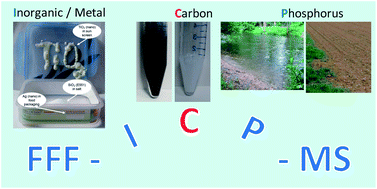当前位置:
X-MOL 学术
›
J. Anal. At. Spectrom.
›
论文详情
Our official English website, www.x-mol.net, welcomes your
feedback! (Note: you will need to create a separate account there.)
Extending the capabilities of field flow fractionation online with ICP-MS for the determination of particulate carbon in latex and charcoal†
Journal of Analytical Atomic Spectrometry ( IF 3.1 ) Pub Date : 2018-07-10 00:00:00 , DOI: 10.1039/c8ja00101d Volker Nischwitz 1, 2, 3, 4, 5 , Nina Gottselig 5, 6, 7, 8, 9 , Anna Missong 3, 5, 10, 11, 12 , Erwin Klumpp 3, 5, 10, 11, 12 , Melanie Braun 5, 6, 7, 8, 9
Journal of Analytical Atomic Spectrometry ( IF 3.1 ) Pub Date : 2018-07-10 00:00:00 , DOI: 10.1039/c8ja00101d Volker Nischwitz 1, 2, 3, 4, 5 , Nina Gottselig 5, 6, 7, 8, 9 , Anna Missong 3, 5, 10, 11, 12 , Erwin Klumpp 3, 5, 10, 11, 12 , Melanie Braun 5, 6, 7, 8, 9
Affiliation

|
There is a broad range of carbon based engineered particles including polymer latex particles and carbon black. Also in environmental systems particulate carbon such as humic acids and soot or coal (the latter two summarized as black carbon) is of great importance and is involved in nutrient storage and (re)cycling. Therefore, detailed characterisation of the size distribution and elemental composition of such particles is required to understand the material properties and their environmental relevance. Field flow fractionation (FFF) online with inductively coupled plasma mass spectrometry (ICP-MS) is routinely applied for the characterisation of metal containing particles. However, the far majority of FFF studies relies on UV detection for organic carbon while elemental detection of carbon has hardly been used. Our previous work demonstrated the capability of FFF-ICP-MS for the determination of carbon in fine particulate matter, focusing on humic acid in water samples. The current work investigates the feasibility of carbon detection and quantification in larger particles with sizes up to about 750 nm. For this purpose, latex particle size standards of 21 nm, 100 nm, 250 nm and 740 nm were analysed as well as extracts of charcoal spiked soil. Elemental analysis using combustion techniques was employed as reference for the total carbon content of the samples to establish a mass balance. Recoveries for FFF separation of latex particle standards were in the range from 69% to 83% and in the range from 78% to 104% in flow injection mode. Carbon mass balance calculated from FFF fractionation, ultrafiltration and total content for the extracts from soil and charcoal spiked soil achieved 76% to 105%. Variation of the sampling depth was investigated to check if increased dwell time of the particles in the plasma affects the carbon ionisation and quantification. No significant change of carbon recoveries was observed, yet the signal to noise ratio improved 3-fold. This study provides a method for the analyses of carbon containing particles via FFF-ICP-MS, which allows for the first time the simultaneous measurement of carbon and other nutrients and is hence more timesaving than other methods.
中文翻译:

借助ICP-MS在线扩展现场流分馏的能力,以测定乳胶和木炭中的颗粒碳†
各种各样的碳基工程颗粒包括聚合物胶乳颗粒和炭黑。同样在环境系统中,诸如腐殖酸,煤烟或煤等颗粒碳(后两者概括为黑碳)也非常重要,并参与营养物的储存和(再)循环。因此,需要详细表征这些颗粒的尺寸分布和元素组成,以了解其材料特性及其与环境的相关性。在线使用电感耦合等离子体质谱仪(ICP-MS)在线进行流场分级分离(FFF)通常用于表征含金属的颗粒。但是,大多数FFF研究依赖于有机碳的UV检测,而几乎没有使用碳的元素检测。我们之前的工作证明了FFF-ICP-MS能够测定细颗粒物中碳的能力,重点是水样品中的腐殖酸。目前的工作研究了在最大约750 nm的较大颗粒中进行碳检测和定量的可行性。为此,分析了21 nm,100 nm,250 nm和740 nm的乳胶粒度标准以及木炭加标土壤的提取物。使用燃烧技术的元素分析作为样品总碳含量的参考,以建立质量平衡。在流动注射模式下,乳胶颗粒标准品的FFF分离回收率在69%至83%的范围内,在78%至104%的范围内。通过FFF分馏计算出的碳质量平衡,土壤和木炭加标土壤中提取物的超滤和总含量达到了76%至105%。研究了采样深度的变化,以检查等离子体中颗粒停留时间的增加是否会影响碳的离子化和定量。没有观察到碳回收率的显着变化,但是信噪比提高了3倍。这项研究提供了一种分析含碳颗粒的方法通过FFF-ICP-MS,这是首次允许同时测量碳和其他营养素,因此比其他方法节省更多时间。
更新日期:2018-07-10
中文翻译:

借助ICP-MS在线扩展现场流分馏的能力,以测定乳胶和木炭中的颗粒碳†
各种各样的碳基工程颗粒包括聚合物胶乳颗粒和炭黑。同样在环境系统中,诸如腐殖酸,煤烟或煤等颗粒碳(后两者概括为黑碳)也非常重要,并参与营养物的储存和(再)循环。因此,需要详细表征这些颗粒的尺寸分布和元素组成,以了解其材料特性及其与环境的相关性。在线使用电感耦合等离子体质谱仪(ICP-MS)在线进行流场分级分离(FFF)通常用于表征含金属的颗粒。但是,大多数FFF研究依赖于有机碳的UV检测,而几乎没有使用碳的元素检测。我们之前的工作证明了FFF-ICP-MS能够测定细颗粒物中碳的能力,重点是水样品中的腐殖酸。目前的工作研究了在最大约750 nm的较大颗粒中进行碳检测和定量的可行性。为此,分析了21 nm,100 nm,250 nm和740 nm的乳胶粒度标准以及木炭加标土壤的提取物。使用燃烧技术的元素分析作为样品总碳含量的参考,以建立质量平衡。在流动注射模式下,乳胶颗粒标准品的FFF分离回收率在69%至83%的范围内,在78%至104%的范围内。通过FFF分馏计算出的碳质量平衡,土壤和木炭加标土壤中提取物的超滤和总含量达到了76%至105%。研究了采样深度的变化,以检查等离子体中颗粒停留时间的增加是否会影响碳的离子化和定量。没有观察到碳回收率的显着变化,但是信噪比提高了3倍。这项研究提供了一种分析含碳颗粒的方法通过FFF-ICP-MS,这是首次允许同时测量碳和其他营养素,因此比其他方法节省更多时间。











































 京公网安备 11010802027423号
京公网安备 11010802027423号